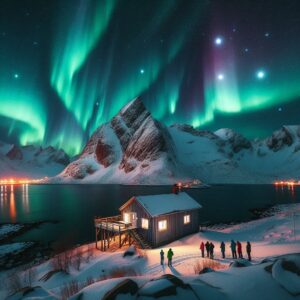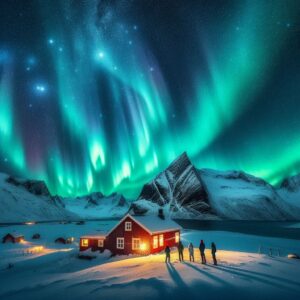 The Northern Lights: A Dance of Lights in the Night Sky
The Northern Lights: A Dance of Lights in the Night Sky
A natural spectacle that captivates the world
The Northern Lights, also known as the Aurora Borealis, is a natural phenomenon that has captivated the imagination of people for centuries. It is a display of vibrant lights in the night sky, which occurs mainly in high latitudes, around the Arctic and Antarctic.
A scientific phenomenon
Far from being magic or witchcraft, the Northern Lights has a scientific explanation. It occurs when charged particles from the sun, known as the solar wind, collide with the atoms in the Earth’s atmosphere. This collision releases energy in the form of light, creating the stunning Northern Lights. The colors that are observed depend on the type of gas that is excited:
- Green and red: Produced by oxygen.
- Blue and violet: Produced by nitrogen.
A moving spectacle
The Northern Lights are not static. They move and change shape constantly, creating a dynamic and captivating spectacle.
A gift from nature
The Northern Lights is a gift from nature that reminds us of the vastness and mystery of the universe. It is a reminder that there are things in this world that go beyond our understanding, things that fill us with wonder and admiration.
Where can you see the Northern Lights?
The best places to see the Northern Lights are in the auroral ring, an oval region that surrounds the Earth’s magnetic poles. In the northern hemisphere, this includes places like:
- Alaska
- Canada
- Iceland
- Norway
- Sweden
- Finland
In the southern hemisphere, the Southern Lights can be seen in Antarctica and in some parts of:
- Australia
- New Zealand
- Chile
When can you see the Northern Lights?
The Northern Lights are more visible during the winter months, when the nights are longer and darker. Auroral activity also depends on the solar cycle, being more intense during periods of maximum solar activity. The next solar activity peak is expected in 2025.
How can you predict the Northern Lights?
There are tools that can help you predict the Northern Lights:
- Kp index: Indicates the intensity of geomagnetic activity.
- Northern Lights forecast: Shows the probability of seeing auroras in a specific location on a specific date and time.
What do you need to see the Northern Lights?
To witness this natural phenomenon, it is important to:
- Get away from light pollution: Find a place with clear skies.
- Dress warmly: Temperatures in the regions where the Northern Lights are observed can be very low.
- Be patient: The Northern Lights are not always visible.
- Bring the right camera: With good low-light capability and a tripod.
- Enjoy the show: It is a unique and unforgettable phenomenon.
Additional tips:
- Plan your trip in advance: Book accommodation and transportation in advance, especially during peak season.
- Research the place: Learn about the best areas to see the Northern Lights.
- Join a guided tour: It can be a good option to learn more about the phenomenon.
- Respect the environment: Do not litter or damage nature.
The Northern Lights is a life-changing experience. It is a natural spectacle that will leave you breathless and filled with wonder. If you have the opportunity to see it, don’t miss it.



